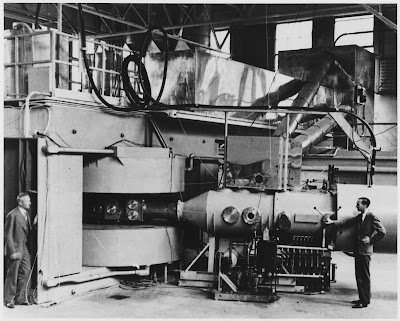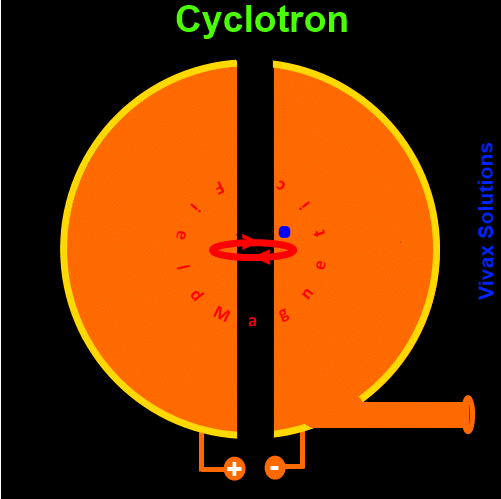Today (January 8, 1891) is the birthday of Walther Bothe, the Nobel Prize-winning nuclear physicist who developed the first functional cyclotron in Germany.

Walther Wilhelm Georg Bothe was
born on January 8, 1891, the son of Frederick Bothe and Charlotte Hartung. From
1908 to 1912 he studied at Frederick-Willems-University. In 1913 he joined the
Reach Institute of Physics and Technology (PDR) as a training assistant to Max
Planck at the newly developed laboratory for radiation. He received his
doctorate in 1914 under the supervision of Planck. In 1913, he joined the newly
established Radiology Laboratory at the Institute of Physics and Technology of
the German Empire. He served in the German army during World War I in 1914 and
was taken prisoner of war by the Russians. He then returned to Germany in 1920.
Returning to work in the radiology laboratory, he developed coincidence methods
for the study of nuclear reactions and used them to study nuclear reactions,
the Camden effect, cosmic rays, the wave-particle duality of radiation, and so
on.


In 1930 he became a full-time
professor and director of the Department of Physics at Keisen University. In
1932, he became director of the Institute of Physics and Radiology at the
University of Heidelberg. He was expelled from this position by elements of the
Deutsche Physic movement. To prevent immigration from Germany, he was appointed
director of the physics institute of the Kaiser Wilhelm Institute of Medical
Research (KWImF) in Heidelberg. There, he built the first operational cyclotron
in Germany. He also became a president of the German nuclear program, also
known as the Uranium Club. It was started in 1939 under the supervision of the
Army Command Office. The great patriot Walther Pothe was a prolific painter and
pianist.


By the end of 1937, Bothe and
Gentner's rapid successes with the building and research applications of the
Van de Graff generator led to the consideration of building a cyclotron. Led to
the ordering of a magnet from Siemens in 1938. However, further funding became
problematic. During this time, Gentner continued his research on nuclear photo factivity.
With the help of the Van de Graf generator, it was upgraded to produce energies
below 1 M.V. After completing his research series on 7Li (p, gamma) and 11B (p,
gamma) reactions and the nuclear isomer 80Br, Gentner devoted his entire effort
to building the planned cyclotron. To facilitate cyclotron construction, in
late 1938 and 1939, with the help of the Helmholtz-Kesselseft Co., Gentner was
sent to the Radiation Laboratory at the University of California. Berkeley,
California. As a result of the visit, Gentner Emilio G.Formed a collaborative
relationship with Secrecy and Donald Cookie.

After a warship between France
and Germany in the summer of 1940, Bothe and Gentner received orders to explore
the cyclotron Frederick Joliet-Curie, built in Paris. Although it was built, it
is not yet operational. In September 1940, Gentner received orders to form a
team to activate the cyclotron. Hermann Dunzer of the University of Frankfurt
took part in the effort. While in Paris, Gentner was able to free both
Frederick Joliet-Curie and Paul Lange, who had been arrested and detained. At
the end of the winter of 1941/1942, the cyclotron operated with a 7-MeV beam of the deuteron. Uranium and thorium were irradiated by the beam. It was not until
1941 that Bothe bought all the funds needed to complete the construction of the
cyclotron. The magnet was delivered in March 1943, and the first beam of
Deuteron was ejected in December. The inaugural ceremony for the cyclotron took
place on June 2, 1944. Despite other cyclotrons in construction, Potash was the
first functional cyclotron in Germany.


In 1946, he was director of the
physics institute at KWIMF and was re-appointed as a professor at the
University of Heidelberg. He shared the 1954 Nobel Prize in Physics with Max
Bourne for his discovery of coincidences. From 1956 to 1957 he was a member of
the Nuclear Physics Working Group in Germany. Walther Bothe, who developed the
first functional cyclotron in Germany, left Heidelberg, West Germany, on
February 8, 1957, at the age of 66. Within a year of Bothe's death, his physics
firm at KWIMF was elevated to the status of a new entity under the Max Planck
Society. It later became the Max Planck Institute for Atomic Physics. Its main
building was later renamed the Bothe Laboratory.
Source By: Wikipedia
Information: Ramesh, Assistant
Professor of Physics, Nehru Memorial College, Puthanampatti, Trichy.
Get information like this
https://t.me/joinchat/jpqj3jQLN51kYTk9
Join Telegram Group.
https://chat.whatsapp.com/FisIzCe4Br2CRgxAiicUnf
Join WhatsApp Group
Thanks.
Also, Read
🛑👍 CSIR-NET Physics Materials and Problems
🛑📕 21 GB and Hundreds of Physics E-Books Collection.
🛑🛥️ How does an Electric Motor work? (DC Motor).
🛑🤹♂️ Science Academies' Summer Research Fellowship Programme for Students and Teachers 2022.
🛑🔌 How does a Transformer work - Working Principle electrical engineering.
🛑🎙️ Transistors Explained - How transistors work.
🛑🔥⚡ How Thermocouples Work - basic working principle.
🛑🔌 Voltage Explained - What is Voltage? Basic electricity potential difference
🛑🔌 What is CURRENT– electric current explained, electricity basics.


.jpg)
No comments:
Post a Comment